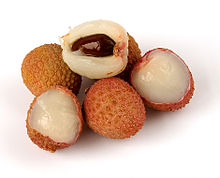Aroma of wine

The aromas of wine are more diverse than its flavours. The
Aroma vs. bouquet

In professional wine tasting, there is generally a distinction made between "aromas" and a wine's "bouquet" while in casual wine tasting these two terms are used interchangeably. An aroma refers to the smells unique to the
The technique of microoxygenation affects the aromatic bouquet.[3]
Components of a wine's aroma
Within wine there are

The majority of volatile compounds responsible for aroma combine with
Study of the compounds responsible for aroma and flavour, as well as their correlation with a wine's quality, continues. As understanding of these compounds grows, there is concern that wines in the future could be "manipulated" through the use of chemical additives to add complexity and additional aromas to wine (such as creating a manufactured
Identified aroma compounds
Some of the identified aroma compounds include the following:[4]
- Methoxypyrazine – grassy, herbaceous aroma compound associated with Cabernet Sauvignon and Sauvignon blanc.
- .
- megastigmatrienone which produces some of the spice notes associated with Chardonnay and zingerone responsible for the different spice notes associated with Syrah. Other norisoprenoids include raspberry ketone which produces some of the raspberry aromas associated with red wine, damascenone which produces some of the rose oil aromas associated with Pinot noir, and vanillin.
- Sylvaner.
Esters
Some of the aromas perceived in wine are from
In wine tasting
The sense of smell and detecting the aromas in wine is the primary means through which wine is tasted and evaluated. Prior to tasting the wine, wine drinkers will often smell the wine in the glass.[8] Large bowl glasses with tapered openings, some of which are specifically designed to enhance aromatics of different wines, can assist in capturing more aromatics within the glass for the drinker to detect. Wines served at warmer temperature will be more aromatic than wine served cooler due to heat's ability to increase the volatility of aromatic compounds in the wine. Swirling, or aerating, the wine will increase available surface area, increasing the rate at which aroma molecules volatilize. Some subtle aromatics can be overwhelmed by more dominant aromatics that arise after swirling, so most professional tasters will sniff the wine briefly first before swirling. The closer the nose is to the wine, even right inside the glass, the greater chances of aromatics being captured. A series of short, quick sniffs versus one long inhale will also maximize the likelihood of aromatics being detected. The human nose starts to "fatigue" after around six seconds and so a pause may be needed between sniffs.[5]
When wine is sipped, it is warmed in the mouth and mixes with
Detecting an aroma is only part of wine tasting. The next step is to describe or communicate what that aroma is and it is in this step that the subjective nature of wine tasting appears. Different individuals have their own way of describing familiar scents and aromas based on their unique experiences. Furthermore, there are varying levels of sensitivity and recognition thresholds among humans of some aromatic compounds. This is why one taster may describe different aromas and flavours from another taster sampling the very same wine.[8]
See also
References
- ISBN 0-19-860990-6
- ^ ISBN 0-19-860990-6
- ^ ISBN 0-19-860990-6
- ^ ISBN 1-56305-434-5
- ISBN 0-19-860990-6
- ^ ISBN 0-7566-1324-8
